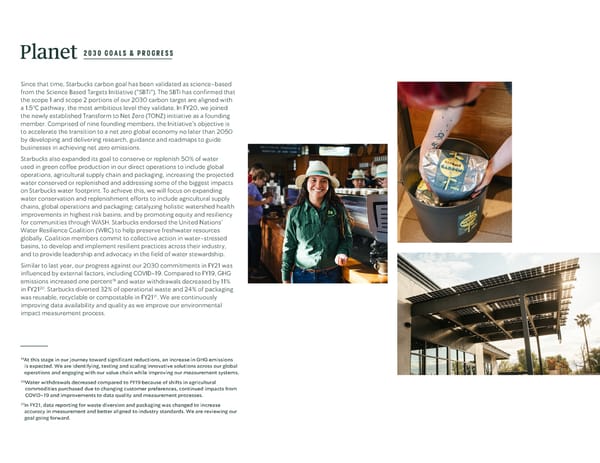2030 GOALS & PROGRESS Planet Since that time, Starbucks carbon goal has been validated as science-based from the Science Based Targets Initiative (“SBTi”). The SBTi has confirmed that the scope 1 and scope 2 portions of our 2030 carbon target are aligned with a 1.5°C pathway, the most ambitious level they validate. In FY20, we joined the newly established Transform to Net Zero (TONZ) initiative as a founding member. Comprised of nine founding members, the Initiative’s objective is to accelerate the transition to a net zero global economy no later than 2050 by developing and delivering research, guidance and roadmaps to guide businesses in achieving net zero emissions. Starbucks also expanded its goal to conserve or replenish 50% of water used in green coffee production in our direct operations to include global operations, agricultural supply chain and packaging, increasing the projected water conserved or replenished and addressing some of the biggest impacts on Starbucks water footprint. To achieve this, we will focus on expanding water conservation and replenishment efforts to include agricultural supply chains, global operations and packaging; catalyzing holistic watershed health improvements in highest risk basins; and by promoting equity and resiliency for communities through WASH. Starbucks endorsed the United Nations’ Water Resilience Coalition (WRC) to help preserve freshwater resources globally. Coalition members commit to collective action in water-stressed basins, to develop and implement resilient practices across their industry, and to provide leadership and advocacy in the field of water stewardship. Similar to last year, our progress against our 2030 commitments in FY21 was influenced by external factors, including COVID-19. Compared to FY19, GHG 19 emissions increased one percent and water withdrawals decreased by 11% 20 in FY21 . Starbucks diverted 32% of operational waste and 24% of packaging 21 was reusable, recyclable or compostable in FY21 . We are continuously improving data availability and quality as we improve our environmental impact measurement process. 19 At this stage in our journey toward significant reductions, an increase in GHG emissions is expected. We are identifying, testing and scaling innovative solutions across our global operations and engaging with our value chain while improving our measurement systems. 20 Water withdrawals decreased compared to FY19 because of shifts in agricultural commodities purchased due to changing customer preferences, continued impacts from COVID-19 and improvements to data quality and measurement processes. 21 In FY21, data reporting for waste diversion and packaging was changed to increase accuracy in measurement and better aligned to industry standards. We are reviewing our goal going forward.
 ESG Report | Starbucks Page 32 Page 34
ESG Report | Starbucks Page 32 Page 34